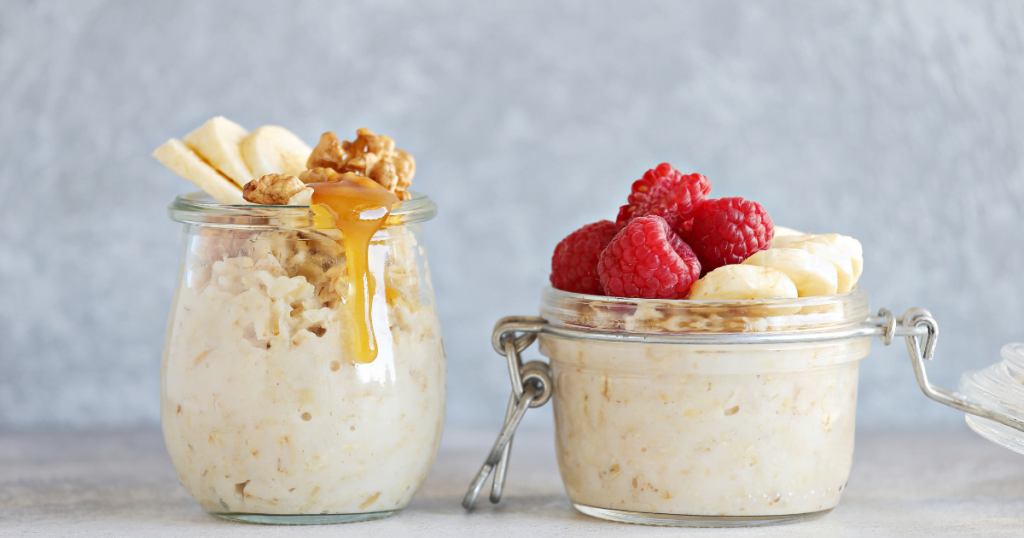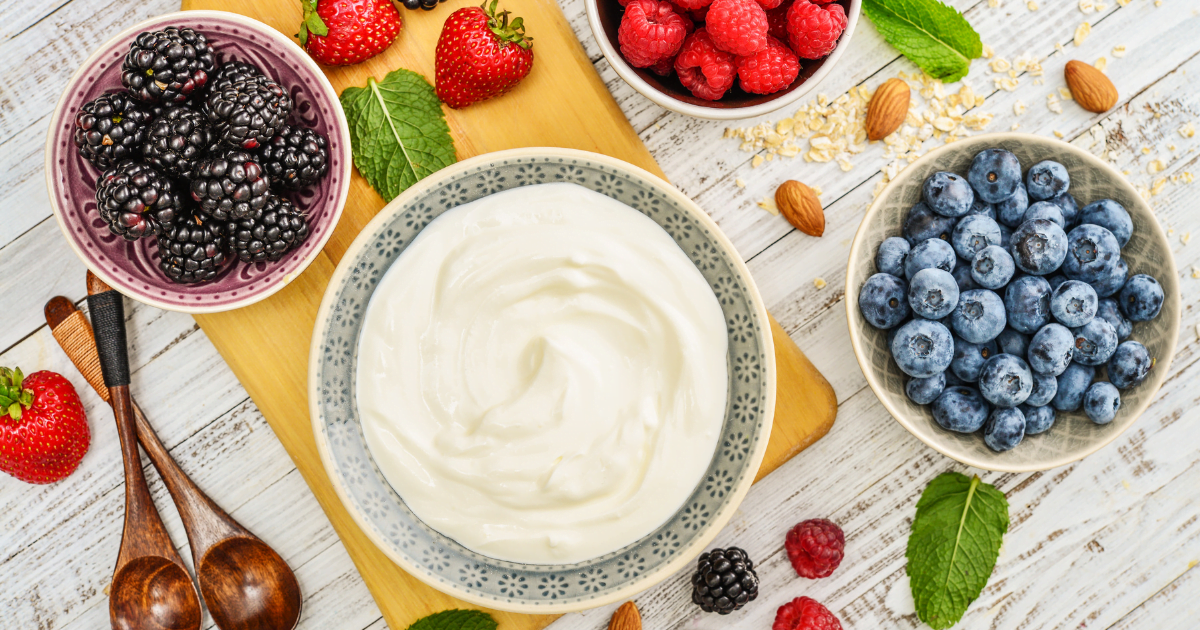Are you gearing up for a big race this season and logging some tough training hours? Or maybe you are beginning a new journey with exercise. Either way, you might be looking for convenient (and delicious) ways to use food to help you recover faster and help prevent injury.
Or maybe you never even considered that recovery foods could be delicious? Spoiler, they certainly can be!
I’m Angie, Registered Dietitian and sports nutrition expert. I am also an age-group triathlete who personally enhances recovery with foods that I think are delicious. One of my favorite parts about working with athletes is helping them get the most out of their training and competitions by teaching them to fuel and recover with delicious food that they actually enjoy – life is too short to choke down recovery foods that aren’t tasty.
In this blog post, I’ll walk you through the building blocks of what makes a good recovery food “good,” when and why we want to prioritize recovery foods, and heck, why we want them to be delicious. I’ll leave you with my top 10 tried and true delicious recovery foods and easy ways to include them in your routine.
(and if you just don’t want to wait, click here to see my full guide).
Let’s dig in!
Why do we need Recovery Foods?
When you are exercising or training, your body can quickly lose fluids, electrolytes, and glycogen, the stored form of carbohydrates in your body.
Your muscles may also experience some stress and strain and would benefit from a good hit of protein to decrease soreness and promote recovery.
The best recovery foods happen at the right time and include foods that contain both carbohydrates and protein, as well as electrolytes and fluids. This power combo allows you to get the most benefit from your training by replacing losses so you can recover faster and perform at your best at your next session.
What makes a “good” recovery food?
The basic building blocks of a recovery food include substantial sources of:
- Carbohydrates (approximately 1-1.2 grams/kg, depending on the intensity and duration of the session)
- Protein (.25 to .4 grams/kg or roughly 20-40 grams)
- Fluids to match losses from sweat, which are highly variable. Aim for at least 16 ounces, but you may need double to triple this amount if you are a heavy sweater.
- Electrolytes, particularly sodium, to replace losses in sweat and help restore fluid balance. Again this is highly variable; one liter of sweat can contain a range of 200-2000 mg of sodium.
When is the best time to include recovery foods?

Some studies show that athletes recover faster and more completely when recovery foods are consumed within 30-45 minutes of their exercise wrapping up (1).
While you may not think it’s a big deal to eat later than that, it can be. One study showed that glycogen replenishment in your muscles can be 50% less when recovery foods are delayed for 2 hours (2). This means that your muscles don’t have as much fuel available for your next big workout.
No matter what recovery foods you choose, I’ll encourage you to prioritize foods that you actually like, not just the ones that meet your recovery nutrition targets. I’ll explain why next.
Why are delicious recovery foods important?
As much as I love crunching numbers as a dietitian, I always want to make sure that my clients actually enjoy the foods that I recommend. Satisfaction matters!
Some athletes or active people have a difficult time prioritizing recovery meals or snacks.
I’ve heard a lot of reasons that this feels challenging from my clients! Here are some things that my clients tell me preclude them from refueling in a timely manner:
- They are too busy following a workout (need to quickly shower and get to work, for example)
- They have post-exercise appetite suppression, which is common after intense training (3)
- They have decision fatigue following a workout and feel like they don’t make good choices
- They don’t enjoy their recovery foods or don’t know what to choose
I have found that having go-to recovery foods that are delicious makes the refueling process more enjoyable and easier to make part of your routine!
Top 10 most delicious recovery foods

In this recipe round-up, I’ve included my top ten favorite recovery recipes for athletes to love. Many of these recipes can be prepped ahead and several are portable, as well. I know so many athletes are on the go 24/7 and need food ideas that can keep up.
With each recipe, I also explain why it is a good recovery food.
To download the full guide, with recipes, please click here.
Without further adieu, here are my favorites!
Protein Smoothie with bananas & berries
- This smoothie packs the quadruple punch by providing carbohydrates, protein, fluid, and electrolytes in a convenient and delicious, portable package.
- The berries are rich in antioxidants, which help reduce inflammation and promote fast recovery.
- The banana provides an excellent source of carbohydrates as well as potassium to offset losses from sweat.
- The protein can be customized to meet your dietary needs for replenishment (whey protein, greek yogurt or a plant-based version are all great options).
- This is refreshing and delicious, can be prepped ahead of time, and is easy to sip even in the presence of a diminished appetite. Bonus benefit: helps to replenish fluid losses, as well.
Mediterranean Egg Bake, Toast and Fruit
- Each egg-packed slice provides 18 grams of protein!
- Yummy feta contributes to the protein content and is also a source of probiotics and sodium.
- Two pieces of toast are a delicious way to replenish carbohydrates and can be customized to your liking (whole grain, gluten free, etc.).
- A cup of fruit, like berries or bananas, provides 15-20 additional grams of carbohydrates, as well as fiber and vitamins.
- It’s an easy, quick, and convenient make-ahead breakfast recovery meal just waiting to be enjoyed when you are done with your workout. Meals like this aren’t reserved just for breakfast, though…can anyone say breakfast for dinner?
Breakfast Burrito
- The tortilla and black beans are great sources of complex carbohydrates.
- The eggs and cheese are high-quality protein sources.
- Spinach or other greens provide vitamin C, folate, vitamins A & K, and potassium.
- Very delicious and easy to prepare ahead of time for busy athletes on the go!
Greek Yogurt Bowl
- Highly customizable and easy to assemble ahead of time.
- Greek yogurt is a great source of protein (about 27gm/cup), as well as essential nutrients such as calcium, phosphorus, riboflavin, vitamin B12, pantothenic acid, and zinc.
- Yogurt is also an excellent source of protein and the amino acid leucine, which are both important for muscle protein synthesis and repair.
- Contains the bonus of probiotics that support gut health and aid in digestion, which is essential to overall recovery.
- Add your favorite fruit, nuts, granola, and other mix-ins to make it the most delicious to you!
Overnight Protein Oats
- Oats are a complex carbohydrate source and provide sustained energy post-workout. They also contain fiber, which aids in digestion and helps regulate blood sugar levels post-exercise.
- Adding yogurt or protein powder is an easy, and tasty way to get in your post-workout protein in one convenient jar.
- Delicious, personalized flavor combinations are almost limitless.
- Super easy to customize to your protein and carbohydrate needs.
- Easy to make ahead for the week and have ready when you are tired or rushed.
Curried Chicken, Sweet Potato & Broccoli
- A simple, delicious meal that can be prepped ahead for lunch or dinner.
- Chicken breasts provide high quality, lean protein essential for muscle recovery and repair.
- Sweet potatoes are high in complex carbohydrates, a delicious way to help replenish glycogen stores.
- Sweet potatoes’ bonus is that they are packed with vitamins and minerals like potassium and vitamin C.
- Broccoli or other green vegetables add essential vitamins and fiber for overall health and recovery.
Salmon Rice Bowl
- Some athletes are a little intimidated by salmon or fish in general, but it’s one of the easiest protein sources to prepare quickly.
- Salmon is also rich in omega-3 fatty acids, which help to reduce inflammation and support recovery.
- Pairing with white, brown, black or wild rice all provide an excellent source of carbohydrates for glycogen replenishment.
- Adding delicious toppers, like avocado, broccoli or other other greens increases the nutritional value and flavor profile of the bowl.
Sheet Pan Tofu + Vegetables Over Quinoa
- Not all protein needs to be animal-based; tofu is a high quality, complete plant-based protein that is inexpensive and easy to prepare.
- Sheet pan meals are super convenient, create minimal mess in the kitchen, and are a great all-in-one option.
- Serve this over a cup of cooked quinoa, which is a great way to replenish carbohydrates (about 39 grams in cup) with some bonus protein (8 grams/cup).
- The flavors in this tofu veggie dish may convert some tofu naysayers!
Chickpea Curry and Quinoa
- Another delicious plant-based recovery meal that is an effortless way to replenish carbohydrates and protein.
- Chickpeas are an excellent source of both carbohydrates and plant-based protein.
- The bonus recovery ingredient in this recipe which gives the dish its bright yellow color: turmeric! Turmeric contains the powerful antioxidant, curcumin, which has been shown to decrease inflammation and help athletes recover faster.
Tart Cherry Juice Spritzer
- While this one is not a complete meal on its own, it’s a great addition to add to your recovery routine.
- Tart cherry juice contains many anti-inflammatory and antioxidant properties and has been shown to decrease muscle soreness and improve athletic performance in several studies.
- Make a tart cherry juice spritzer part of your nightly routine, particularly as a swap for wine or other alcohol, which can be damaging to recovery and performance.
Rock Your Recovery
If you struggle to prioritize recovery foods or feel like your schedule doesn’t allow you to recover and refuel as you would like, please know that you’re not alone: I’m here to help. Download my free guide: Top 10 Delicious Recovery Foods, which includes all of the recipes above. See if you notice a difference in your ability to bounce back and be ready to go for your next session when you include them within 45 minutes of finishing a workout.
You may wonder what it’s like to work with a registered dietitian on your personal fueling goals. I’d say it depends on who you work with! Hopefully, you can tell from this blog post that I prioritize the science of nutritional recovery as much as your enjoyment and ease of implementation…before working with me, a lot of my clients were only focusing on the science part so it is no wonder that they got burnt out eating meals and snacks that didn’t taste good. Could it be that it’s that enjoyment piece that is missing from your routine? I can help with that! When we work together, we’ll be able to customize your eating plan so that you love the foods you’re eating AND you’re hitting your PRs left and right.


0 Comments